Tropical fruits, with their vibrant colors and distinctive tastes, are more than just a visual and gustatory delight. They represent a world of culinary possibilities, from unique beverages to exotic dishes.
For restaurant owners and culinary enthusiasts, these fruits offer an avenue to diversify the menu and cater to a broader audience.

Beyond their delectable taste, many tropical fruits are packed with nutrients, providing a myriad of health benefits.
In this guide, we delve into the world of tropical fruits, exploring their origins, taste profiles, and unique applications. Whether you’re looking to expand your culinary horizons or simply curious about fruits beyond the usual suspects, read on to embark on a tropical journey of discovery.
Did you know? The tropical region, especially the areas around the equator, boasts a diverse range of fruits due to its consistent climate and abundant rainfall.
9 Tropical Fruits You’ve Probably Never Heard Of!
So, buckle up as we embark on this fruity adventure!
1. Dragon Fruit (Pitaya)
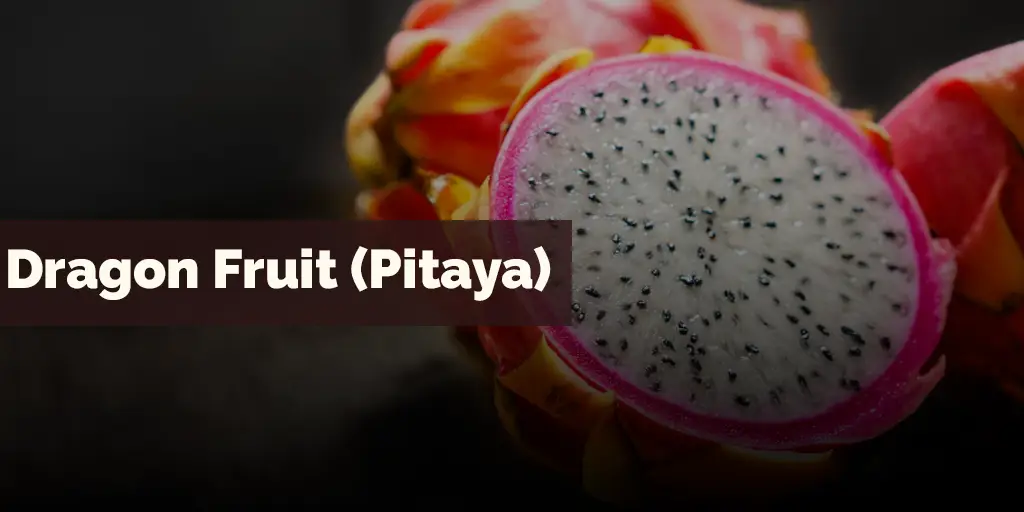
A sight to behold, the Dragon fruit, also known as Pitaya, is characterized by its vibrant pink outer skin adorned with spikey green growths.
But don’t let its appearance intimidate you. Beneath this flamboyant exterior lies a sweet, juicy flesh dotted with tiny black seeds.
Taste Profile
Dragon fruit offers a subtle sweetness, often compared to a blend of kiwi and pear. Its texture, akin to that of kiwifruit because of the crunchy seeds, provides a pleasant contrast to its soft flesh.
Fact: Despite its exotic appearance, Dragon fruit is a cactus species!
Nutritional Benefits
- Rich in Vitamin C: A powerful antioxidant that boosts your immune system.
- High in Fiber: Promotes better digestion and bowel movements.
- Contains Antioxidants: Helps in combating free radicals in the body.
Origin and History
Native to Central America, Dragon fruit has found its way across the globe, especially in Asian countries like Vietnam, Thailand, and the Philippines.
Cultures around the world have not only cherished it for its taste but also utilized it for its medicinal properties.
Popular Uses
- Smoothies: Blend it with some yogurt and honey for a refreshing drink.
- Salads: Add chunks of Dragon fruit to your fruit salad for a burst of color and taste.
- Desserts: It serves as a delightful topping for tarts and cakes.
“Dragon fruit is nature’s testament that the wildest-looking foods often hide the sweetest secrets.” – Anonymous
How to Prepare Dragon Fruit
- Slice the fruit into two halves.
- Using a spoon, gently scoop out the flesh, ensuring you don’t get any of the pink skin.
- Dice or slice as per your requirement.
Pro Tip: The skin of the Dragon fruit, though not edible, can serve as a natural bowl. You can scoop out the flesh, make a fruit salad, and serve it right back in the skin!
2. Passion Fruit (Liliko’i)

The Passion Fruit, or Liliko’i in Hawaiian, may seem unassuming from the outside with its rough, often wrinkled skin.
But crack it open, and you’re greeted with a treasure trove of aromatic, jelly-like seeds that pack a punch of flavor.
Taste Profile
Contrary to its serene appearance, Passion fruit offers a robust flavor profile – a harmonious blend of sweet and tart. Its intense aroma and tangy taste can elevate any dish or drink it’s added to.
Fact: The name “Passion Fruit” doesn’t stem from its intense flavor. Instead, it’s named after the passion flower, from which the fruit originates, and was used by missionaries as an educational symbol of Christ’s passion.
Nutritional Benefits
- Vitamin A and C powerhouse: Essential for maintaining good eye health and boosting immunity.
- Rich in Dietary Fiber: Aids in digestion and maintaining a healthy gut.
- Provides Essential Minerals: Such as iron, magnesium, and phosphorous.
Origin and History
The Passion fruit is native to South America, particularly Brazil, Paraguay, and Argentina. However, its delightful taste and myriad benefits have made it a favorite across the globe, from Africa to Australia.
Popular Uses
- Juices: Its tangy flavor makes for a refreshing juice, especially when sweetened with a touch of honey.
- Desserts: A popular topping for pavlovas, tarts, and ice creams.
- Sauces and Dressings: The tartness of Passion fruit can add a zesty twist to salads and grilled meats.
“Passion fruit has the power to instantly transport you to a tropical paradise, with just one bite.” – Culinary Explorer
How to Prepare Passion Fruit
- Slice the fruit into halves using a sharp knife.
- Use a spoon to scoop out the aromatic pulp and seeds.
- If you prefer a seedless experience, strain the pulp through a fine-mesh sieve.
Pro Tip: Passion fruit pulp can be stored in the freezer for up to six months, ensuring you have a tropical treat even in the coldest of winters!
3. Rambutan
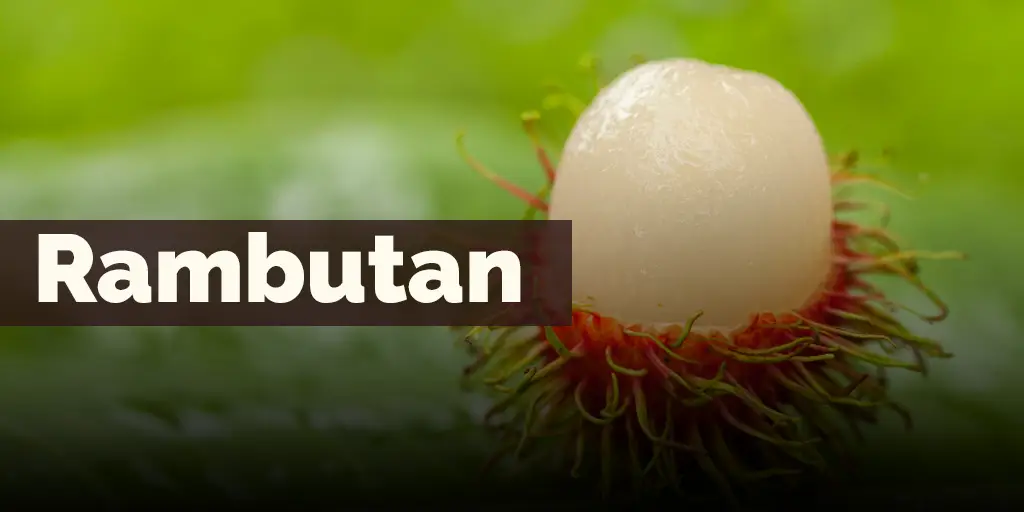
Resembling a hairy lychee, the Rambutan is a visual treat with its hairy exterior and translucent, juicy flesh inside. This fruit, often termed as a ‘hairy cherry’, is a favorite in many Southeast Asian countries.
Taste Profile
Rambutan offers a sweet and slightly acidic taste, reminiscent of grapes and lychee. Its juicy texture combined with its mild flavor makes it a refreshing treat on a hot day.
Fact: The word “Rambutan” is derived from the Malay word ‘rambut’, which means hair, aptly describing its unique appearance.
Nutritional Benefits
- Vitamin C Rich: Aids in collagen production and ensures healthy skin.
- Good Source of Water: Helps in staying hydrated.
- Contains Essential Minerals: Such as calcium, iron, and potassium.
Origin and History
Originating from Southeast Asia, Rambutan has been cultivated for centuries in regions like Malaysia, Thailand, the Philippines, and Indonesia. It’s not just a delicious treat but also holds cultural significance in many Southeast Asian traditions.
Popular Uses
- Fresh Snack: Best enjoyed fresh, simply peel and eat!
- Desserts: Can be used in fruit salads, tarts, and puddings.
- Beverages: Makes a flavorful addition to cocktails and mocktails.
“With its wild exterior and sweet soul, Rambutan teaches us to never judge a book (or fruit) by its cover.” – Fruit Enthusiast
How to Prepare Rambutan
- Make a shallow cut around the circumference of the fruit with a knife.
- Gently twist and open the fruit to reveal the juicy flesh.
- Pop the flesh out and enjoy. Be cautious of the seed in the center!
Pro Tip: While the seed is inedible and slightly bitter, the flesh around it is the sweetest!
4. Acai
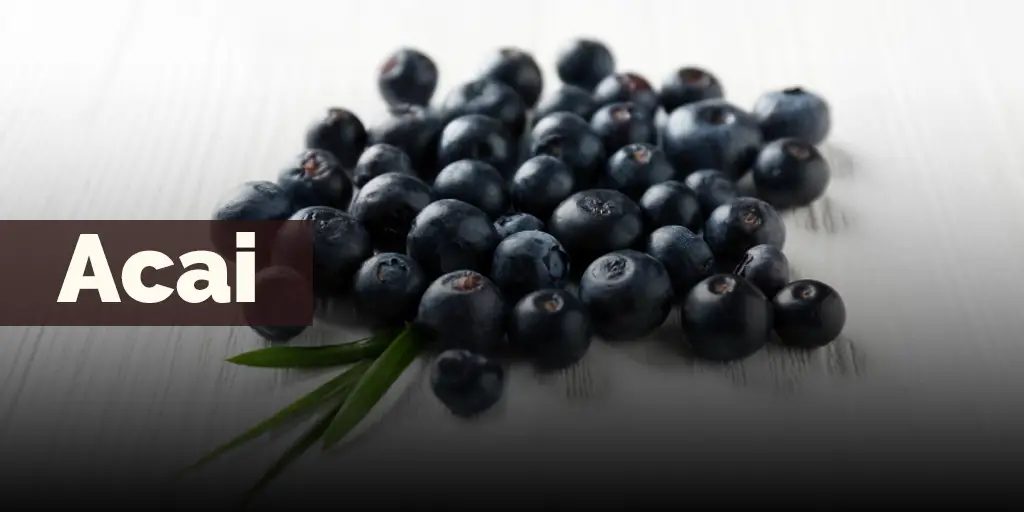
The Acai berry, a small, dark purple fruit, has gained immense popularity in recent years, especially in the realm of health and wellness. Often termed a “superfood,” Acai is native to the rainforests of South America.
Taste Profile
Acai has an earthy flavor, often described as a cross between blackberries and unsweetened chocolate. Its unique taste is complemented by its creamy texture, making it a favorite base for smoothie bowls.
Fact: Acai berries are not technically berries. They are drupes, which means they have a central pit rather than seeds.
Nutritional Benefits
- Antioxidant Powerhouse: Helps combat oxidative stress and inflammation.
- Heart-Healthy Fats: Contains Omega-3, Omega-6, and monounsaturated oleic acid.
- Rich in Fiber: Supports a healthy digestive system.
Origin and History
Acai has been consumed by indigenous tribes of the Amazon rainforest for centuries. It played a vital role in their diet, providing essential nutrients and energy. The tribes also believed in its medicinal properties, using it to treat various ailments.
Popular Uses
- Acai Bowls: A blend of frozen Acai, bananas, and other fruits, topped with granola, nuts, and fruits.
- Juices: Its rich flavor complements other fruits, making it a popular juice ingredient.
- Supplements: Due to its health benefits, Acai is often found in pill or powder form.
“Acai does more than just satisfy your taste buds; it nourishes your body from the inside out.” – Nutritionist
How to Use Acai
- Acai is most commonly available in frozen pulp or powder form outside of its native regions.
- Blend the frozen pulp with fruits like banana or strawberries to create a thick base for smoothie bowls.
- Sprinkle the powder over cereals, yogurts, or incorporate it into baked goods for an antioxidant boost.
Pro Tip: Due to its popularity, many products labeled “Acai” might contain fillers or additives. Always opt for pure, organic Acai products to reap its full benefits!
5. Jackfruit
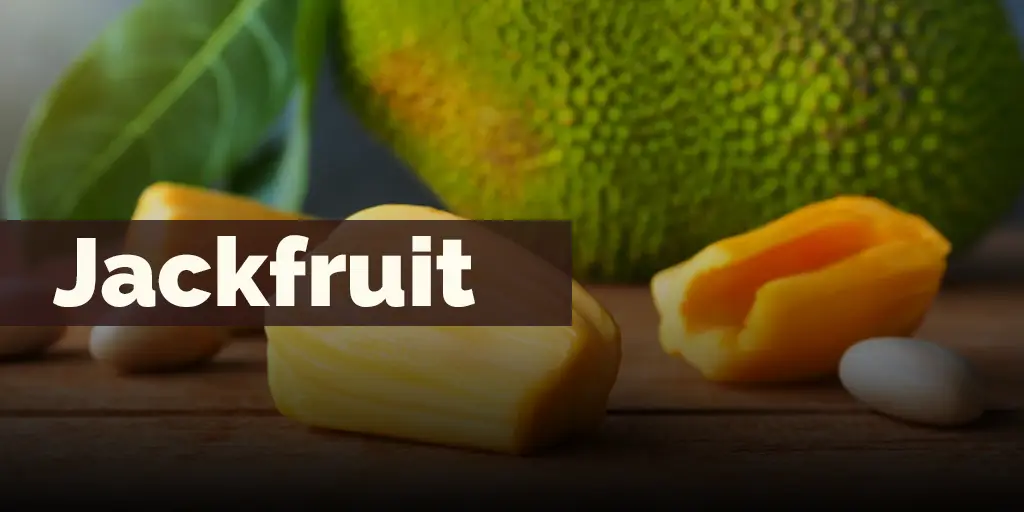
The Jackfruit, with its spiky exterior and massive size, is the largest fruit that grows on a tree. Native to South India, it’s a versatile fruit that can be enjoyed both ripe and unripe.
Taste Profile
Ripe Jackfruit is sweet with hints of mango, banana, and melon. Its yellow flesh is fragrant and has a chewy texture. Unripe Jackfruit, on the other hand, is neutral in taste, making it an excellent meat substitute in savory dishes.
Fact: A single Jackfruit can weigh up to 80 pounds!
Nutritional Benefits
- Rich in Vitamin C: Boosts the immune system and promotes healthy skin.
- High in Potassium: Supports cardiovascular health and balances electrolytes.
- Dietary Fiber: Aids digestion and promotes gut health.
Origin and History
While Jackfruit is now found across the tropical regions of the world, it originated in the rainforests of the Western Ghats of India.
In addition to its culinary uses, it holds cultural and religious significance in many Southeast Asian cultures.
Popular Uses
- Fruit Salads: Ripe Jackfruit bulbs can be eaten raw, often as part of fruit salads.
- Meat Substitute: Unripe Jackfruit, when cooked, has a texture similar to shredded chicken or pork, making it a popular vegetarian substitute.
- Desserts: In South Asia, ripe Jackfruit is used in making various traditional desserts.
“Jackfruit is a testament to nature’s bounty – it feeds, nourishes, and delights all at once.” – Culinary Historian
How to Prepare Jackfruit
- Due to its size and sticky sap, oiling your knife and hands is recommended before cutting.
- Cut the fruit in half and remove the yellow flesh pods.
- Remove the seeds from the pods before consuming. The seeds, when boiled or roasted, are also edible and taste like chestnuts.
Pro Tip: The leftover core of the Jackfruit, when boiled, can be used in soups or shredded and used in salads!
6. Mangosteen
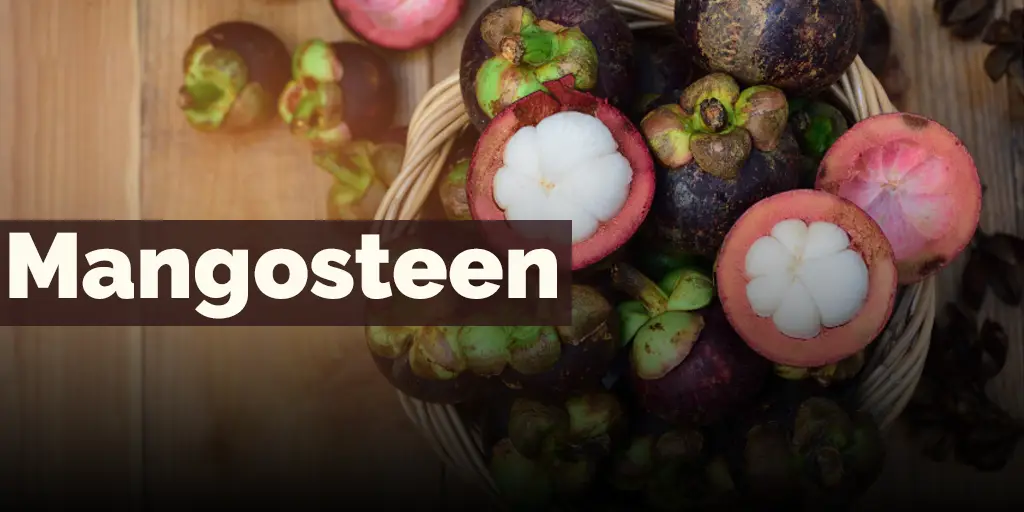
Often crowned as the “Queen of Fruits,” the Mangosteen is a delightful tropical fruit known for its thick, purple rind and juicy, aromatic segments inside. Though it’s small in size, its flavors are nothing short of royal.
Taste Profile
Mangosteen offers a perfect balance of sweet and tangy. Its creamy, white flesh melts in the mouth, releasing a symphony of flavors reminiscent of strawberries, peaches, and a hint of citrus.
Fact: Mangosteen and Mango are entirely different fruits, with no botanical relation despite the similarity in names.
Nutritional Benefits
- Xanthones Galore: Mangosteen is rich in xanthones, powerful antioxidants known for their health benefits.
- Vitamin C Boost: Supports a healthy immune system.
- Anti-Inflammatory: Traditionally used to combat inflammation and related ailments.
Origin and History
Mangosteen, native to the Sunda Islands and the Moluccas of Indonesia, has been cultivated for centuries in Southeast Asia. Its exquisite taste and medicinal properties have made it a sought-after fruit in various cultures.
Popular Uses
- Fresh Snacking: Best enjoyed fresh, straight out of its rind.
- Juices: Its rich flavor makes for a refreshing drink.
- Traditional Medicine: In Southeast Asia, the rind is used to make teas and decoctions for medicinal purposes.
“Mangosteen, with its royal taste and health benefits, truly lives up to its title as the Queen of Fruits.” – Fruit Aficionado
How to Open Mangosteen
- Hold the fruit with the stem facing sideways.
- Using a knife, make a shallow cut around the circumference.
- Gently twist and pull apart to reveal the juicy segments inside.
Pro Tip: The number of leaves at the bottom of a Mangosteen can often indicate the number of segments inside!
7. Lychee
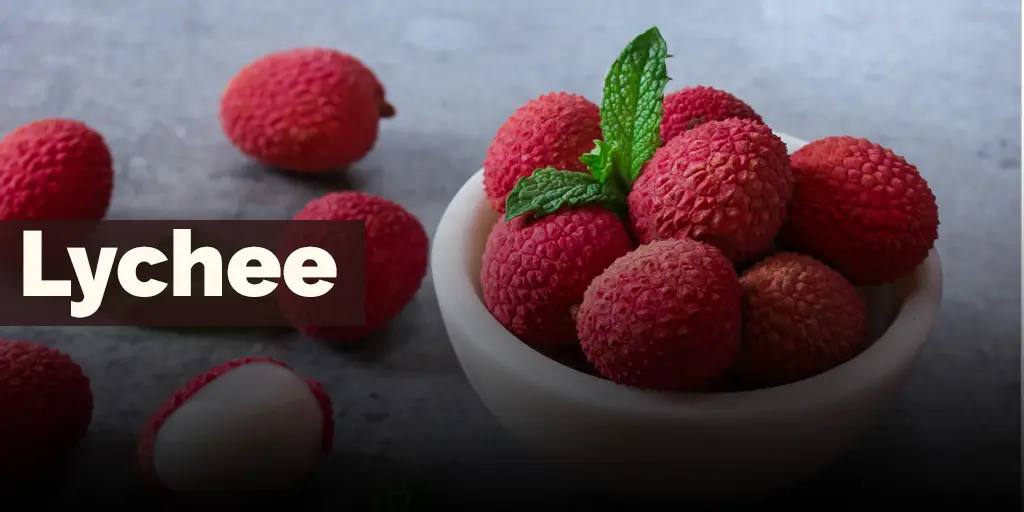
The Lychee, with its rough, red exterior and translucent flesh, is a fruit that’s as refreshing as it is sweet. Hailing from China, this small fruit has made its mark worldwide, especially in Asian cuisines.
Taste Profile
Lychee offers a sweet, floral taste with hints of rose, watermelon, and grape. Its juicy texture and distinct aroma make it a favorite during its short seasonal availability.
Fact: Lychee has been cultivated in China for more than 2000 years and holds cultural significance in various Chinese traditions.
Nutritional Benefits
- Vitamin C Powerhouse: Supports skin health and immunity.
- Rich in B Vitamins: Aids in energy production and brain function.
- Good Source of Copper: Essential for red blood cell production.
Origin and History
Lychee, native to the Guangdong and Fujian provinces of China, has been a cherished fruit in Chinese culture for millennia. Today, it’s cultivated in various parts of the world, from India to the United States.
Popular Uses
- Fresh Consumption: Often eaten fresh, after peeling the skin.
- Beverages: Lychee martinis and mocktails are popular choices.
- Desserts: Used in ice creams, jellies, and tarts.
“A bite into a Lychee is like a burst of summertime freshness.” – Culinary Expert
How to Prepare Lychee
- Make a small incision in the skin using a knife or your fingernail.
- Peel off the skin to reveal the juicy flesh.
- Consume directly but be mindful of the seed in the center.
Pro Tip: Lychee pairs beautifully with other tropical fruits like coconut and mango, making for delightful fruit salads!
8. Papaya

The Papaya, often referred to as the “fruit of the angels” by Christopher Columbus, is a tropical delight known for its vibrant orange hue and sweet, musky taste. Its buttery texture and myriad health benefits have made it a staple in tropical regions.
Taste Profile
Papaya offers a sweet taste with subtle undertones of melon and apricot. Its soft, butter-like consistency makes it easy to blend, chew, and digest.
Fact: Papaya contains an enzyme called papain, which aids digestion and is used to tenderize meat.
Nutritional Benefits
- Beta-Carotene Rich: Supports eye health and reduces the risk of age-related macular degeneration.
- Digestive Aid: The papain enzyme aids in breaking down proteins.
- High in Vitamin C: Boosts immunity and promotes healthy skin.
Origin and History
Native to Central America, Papaya was spread by Spanish and Portuguese explorers to various parts of the world. Today, it’s cultivated in most tropical regions and is cherished both for its taste and medicinal properties.
Popular Uses
- Salads: Green (unripe) Papaya is a key ingredient in the Thai salad “Som Tam.”
- Smoothies: Ripe Papaya blends smoothly, making it a popular smoothie ingredient.
- Topical Treatment: Used traditionally to treat wounds and burns due to its enzymatic properties.
“Papaya is nature’s blend of sweetness and health, wrapped in a golden-orange hue.” – Health Guru
How to Prepare Papaya
- Slice the fruit lengthwise to reveal its seed-filled center.
- Scoop out the black seeds using a spoon.
- Slice or cube the flesh as per your requirement.
Pro Tip: Papaya seeds, though peppery and bitter, are edible and are known to have various health benefits, including liver detoxification.
9. Guava
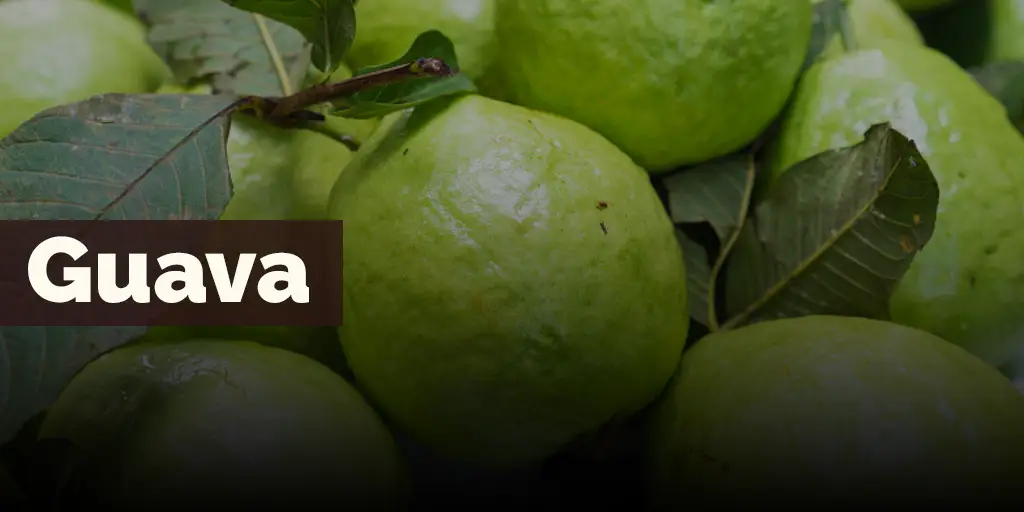
Guava, a humble-looking fruit, is a powerhouse of nutrients and flavors. With its green (or sometimes yellow) skin and pink or white flesh, Guava is a common tropical fruit that boasts a unique flavor profile.
Taste Profile
Guava offers a taste that’s a blend of strawberry and pear, complemented by its floral aroma. Its flesh can range from crunchy (like an apple) to soft and juicy, depending on its ripeness.
Fact: Guava leaves, when boiled and made into a tea, are believed to have numerous medicinal properties, including anti-diarrheal effects.
Nutritional Benefits
- Vitamin C Bomb: Guava contains four times the vitamin C of an orange.
- Rich in Dietary Fiber: Aids digestion and promotes gut health.
- Contains Vitamin A: Essential for good vision and skin health.
Origin and History
While Guava is believed to have originated in Central America, it has been widely adopted in various cultures, from Asia to the Caribbean. Its adaptability to different soil types and climates has made it a favorite among farmers and gardeners.
Popular Uses
- Jams and Jellies: Guava’s pectin-rich nature makes it ideal for making preserves.
- Juices: Its sweet and tangy flavor is refreshing when turned into a drink.
- Fresh Consumption: Simply slice and enjoy!
“In the world of fruits, Guava is a silent achiever – unassuming on the outside but packed with goodness within.” – Dietician
How to Prepare Guava
- Wash the fruit thoroughly to remove any dirt or residues.
- Slice it into quarters or eighths, similar to an apple.
- Remove the seeds if you find them too hard, though they are edible.
Pro Tip: Sprinkling some salt or chili powder on Guava slices can enhance its flavor, offering a delightful blend of sweet, salty, and spicy!
Comparing Tropical Fruits to Common Fruits
While tropical fruits are exotic and offer a unique palate of flavors, it’s interesting to draw comparisons with common fruits to provide a familiar reference point. Here’s a quick comparison:
| Tropical Fruit | Common Fruit | Taste Comparison |
|---|---|---|
| Dragon Fruit | Kiwi | Both have a mildly sweet taste and a similar texture due to their seeds. |
| Passion Fruit | Orange | Passion fruit is tangier, with a more intense aroma. |
| Rambutan | Lychee | Both are similar in taste, though Rambutan is slightly less sweet. |
| Acai | Blackberry | Acai is less sweet, with a hint of chocolatey undertones. |
| Jackfruit | Pineapple & Mango | Jackfruit offers a blend of these flavors, especially when ripe. |
| Mangosteen | Strawberry | Both have a sweet-tart profile, but Mangosteen has a creamier texture. |
| Lychee | Grape | Lychee is sweeter with floral notes. |
| Papaya | Cantaloupe | Both are musky, but Papaya is softer with a buttery texture. |
| Guava | Strawberry & Pear | Guava combines the flavors of these fruits with its unique aroma. |
Benefits of Incorporating Tropical Fruits in the Menu
1. Attracting a Wider Audience: Introducing tropical fruits can cater to global palates, especially those familiar with these fruits from their native regions.
2. Offering Unique Dishes: Tropical fruits provide an opportunity to innovate and offer dishes that stand out from the competition.
3. Health Benefits: Many tropical fruits are nutrient-dense, allowing restaurants to cater to the health-conscious demographic.
4. Storytelling Opportunities: Each tropical fruit comes with its rich history and cultural significance. Sharing these stories can enhance the dining experience.
You May Also Enjoy Reading:
Storage and Preservation of Tropical Fruits
Storing tropical fruits correctly is crucial for maintaining their freshness and flavor. Here are some general guidelines:
- Dragon Fruit, Rambutan, Mangosteen: Store in a cool, dry place. Refrigerate only when ripe to prolong freshness.
- Passion Fruit: Best stored at room temperature until ripened. Refrigerate thereafter.
- Acai: Typically found frozen. Store in the freezer and thaw before use.
- Jackfruit: Once cut, store the remaining fruit in the refrigerator wrapped in cling film or foil.
- Lychee: Refrigerate in a plastic bag with holes for ventilation.
- Papaya, Guava: Store at room temperature until ripened. Refrigerate thereafter.
Conclusion
Tropical fruits, with their unique flavors, textures, and histories, offer a world of culinary opportunities.
Whether you’re a restaurant owner looking to diversify your menu or a culinary enthusiast eager to experiment, these fruits are a treasure trove waiting to be explored.
Dive in, experiment, and let the tropical flavors transport you to sun-kissed shores and balmy evenings.
Frequently Asked Questions (FAQs)
Can I find all these tropical fruits year-round?
While some fruits like Acai are available year-round (mostly frozen), others are seasonal. It’s best to check with local suppliers or specialty stores.
Are the seeds of all these fruits edible?
While many tropical fruits have edible seeds (like Papaya and Guava), some like Mangosteen and Rambutan have seeds that are best avoided due to their bitter taste or hard texture.
Can I use these fruits in savory dishes?
Absolutely! Fruits like Jackfruit and Green Papaya are commonly used in savory dishes in many cultures.
Are tropical fruits allergy-friendly?
While tropical fruits are generally safe for consumption, it’s always a good practice to check for individual allergies, especially when trying a fruit for the first time.



